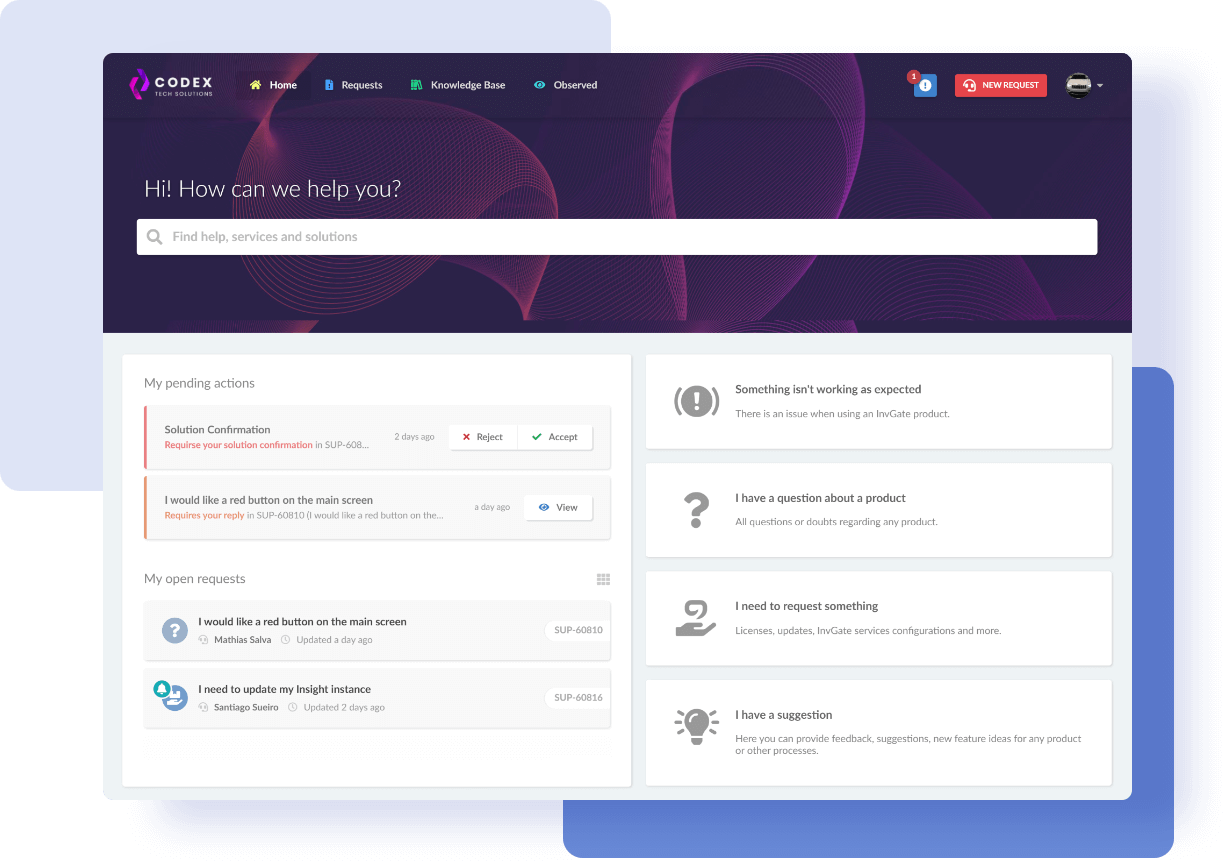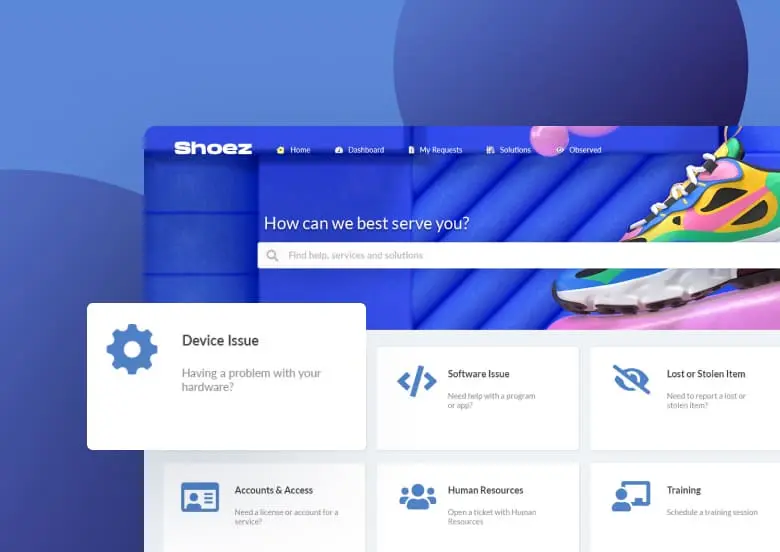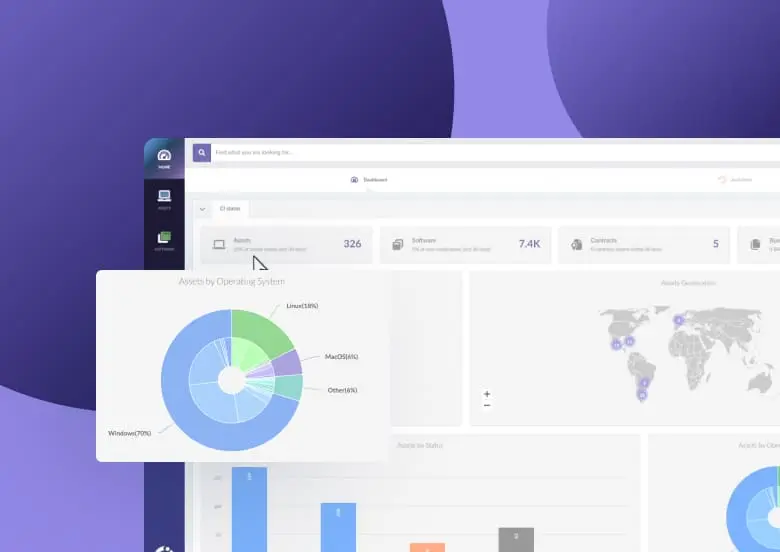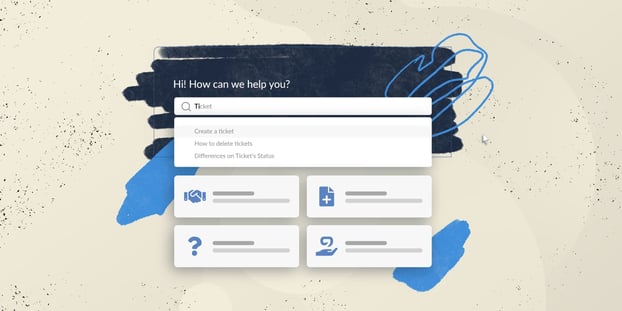Self-service is nothing new. We've all become accustomed to being able to serve ourselves in a variety of situations, such as when we're shopping or banking. And when it comes to IT, self-service is not only desirable but expected. To solve this need, all you need is a self-service portal, and the rest will come.
More and more organizations are turning to IT self-service portals as a way of providing their users with quick access to support, information, and resources – which, in turn, reduces the number of submitted tickets. In fact, according to a survey by Hubspot, 73% of users want to be able to solve issues independently.
So, if you haven’t already implemented it in your company, this guide will help you set up your own self-service portal on InvGate Service Management easily and effectively. Let’s get to work!

What is IT self-service?
IT self-service – also known as tier 0 of the five IT support levels – provides employees with the ability to solve their technological problems and access the services they need in a quick and efficient manner. It encourages users to take responsibility for their own IT needs, allowing them to quickly track, diagnose, and troubleshoot their issues without tying up IT staff.
With self-service capabilities, help desk agents are released from common tickets that can be solved with a knowledge base article and can then focus on more complex tasks that do require their expertise. Thus, they make a great way of maintaining efficiency and service expectations under tighter budgets.
What is an IT self-service portal?
The goal of an IT self-service portal is to make employees as self-sufficient and independent as possible. So, it has to provide them with everything they need to solve their daily tasks.

As you can see in the InvGate Service Management example above, the common elements of a service portal include:
- Knowledge base – A complete knowledge base with articles specifically made for the end-users is a must. This way, they will be able to solve simple issues without even contacting an agent.
- Service catalog – It also needs to have a well-built service catalog. This includes categories created with natural language for both users and agents.
- Search bar – Users will try to get things done quickly, and a search bar is a great way to help them.
- Ticket view – Allows employees to see their open and closed tickets, their status, conversations, and detail. This way, they won’t be asking agents how their request is going.
All of this has to be built into an intuitive and easy-to-use interface. Otherwise, adoption rates will be very low because employees will find it easier to create a ticket and wait for a reply rather than solve the issue in a few clicks.
Why do you need self-service? 7 benefits of an IT self-service portal
Many benefits come from self-service. Here are six of the top ones.
1. 24/7 support availability
IT support doesn’t have to stop when your IT service desk analysts have gone home and there’s nobody around to answer the phone. Customers can access self-service whenever they like, even outside of agents’ working hours. So, if someone forgets an account password at 8 p.m., they can just reset it themselves and carry on with their work. There’s no need to hassle anybody out of hours, and no one is prevented from working until the morning when the service desk opens again.
2. Faster resolution and provisioning
Technology is enabling us to do some pretty amazing stuff, but it’s also making us really impatient (as customers) too. Speed is of the essence these days, and that’s feeding into employee expectations in the workplace. People don’t want (or expect) to wait on hold for a service desk analyst to become available if there’s an issue they could resolve themselves.
So, InvGate Service Management lets you act upon the need for speed in different ways, besides creating a self-service portal:
- You can build knowledge base articles to provide solutions to the most common requests before a ticket is created and associate them to a specific category, so they are displayed when the end-user looks for help with their problem.
- You can enable automation within self-service by creating workflows for each type of request to facilitate ticket triage, account creation, and request management.
3. Productivity improvements
Automating manual tasks and empowering end-users to deal with their own IT needs to remove a lot of work from the service desk. Thus, analysts are free of tasks that adds minimal value to deal with complex escalations, aged tickets, or major incidents.
Making room for employees to work on stuff that really benefits from their input increases productivity, not only because it allows staff to focus on more relevant tasks but also because they feel more motivated when contributing to the bigger picture.
Furthermore, self-service increases the customers’ knowledge to solve similar situations in the future quicker, and help colleagues out if they need to.
4. Minimal agent interruptions
Agents are often interrupted by messages asking for help, regardless of their urgency and relevance. But self-service ends that. By providing employee autonomy, it contributes to agents’ better task management – which is especially beneficial for small IT support departments.
And if you still want to keep an eye on urgent tasks or VIP users, you can always automate notifications on InvGate Service Management so they can be solved as fast as possible.
5. Reduced IT costs
The practice of “shifting left” or passing work down the chain reduces IT support costs and ensures that organizations are getting the maximum value out of staff. IT self-service portals do exacty that by solving more basic queries so only the ones that need help from an agent move to the next level of support.
And with InvGate Service Management, you can take cost reduction one step forward by automating workflows.
6. Increased user satisfaction
Empowering end-users to solve their own incidents without having to wait for assistance positively impacts user experience, and thus increases customer satisfaction levels.
Moreover, self-service contributes to offering a personalized support experience. When customizing your portal on InvGate Service Management, you can:
- Create a personalized greeting to welcome users.
- Segment your users according to their roles to only offer information and showcase products and services relevant to them.
- Link shortcuts with the most common requests.
Along with the efficiency that self-service offers, the unlimited availability of support, and the higher accuracy of outputs, customers will be happier with their IT support experience and so more engaged with IT as a whole.
7. Reduced human error
InvGate Service Management’s self-service portal allows users to input their own requests for IT support and services directly. This reduces the need for human intervention in the process, which can decrease the likelihood of errors caused by miscommunication, transcription errors, or other mistakes that can occur when requests are handled manually.
Additionally, the portal can provide users with step-by-step guides and automated processes (like workflows) to ensure that their requests are properly documented and executed, further reducing the chance of human mistakes.
How do self-service portals work?
A self-service portal consists of an application where end-users have access to information and services. It’s like a menu for employees to find everything they need to engage with the IT department.
For it to work properly, it needs certain elements:
- The main menu with shortcuts to the frequently used service categories.
- A search bar to access knowledge base articles or other categories that aren’t displayed in the main menu.
- Access to the rest of the service catalog (according to the users’ roles and privileges) to create requests.
- Access to the history logs, where they can add new comments, leave feedback, or re-open them.
But none of this is useful if the portal isn’t user friendly. Self-service software has to be intuitive to be adopted. If not, you won’t benefit from it.
4 self-service challenges (and how to overcome them)
Before we move onto how to implement an IT self-service portal, you need to know what challenges you might face, to be prepared beforehand.
1. Structure
The first challenge when building a self-service portal is how to structure it. You have to create a portal that suits your clients' needs and behaviors as users.
To achieve it, think about the following questions:
- What are the most common requests in your organization?
- How do end-users understand the IT structure?
- How self-sufficient can end-usersbe?
- Are you just building an IT self-service portal or do you want to expand it to other areas of the company?
Though it might seem daunting, InvGate Service Management’s customizable templates make all the difference. They are the perfect starting point to build a portal tailored to your users’ (and your) needs.
2. Engagement
Employees tend to think that the simplest and fastest way to solve their problems is to approach the agent in person or by chat and ask them what they need. Once that behavior has been established is not simple to change it.
But not everything is lost; there are some features that can encourage self-service adoption. For instance, you can set a higher priority for tickets that are created through the service catalog and a lower priority for those that arrive by email or chatbox.
Also, set related knowledge base articles to pop up whenever employees start new requests. This will encourage them to try fixing simple things by themselves before asking for help. Lastly, it’s key to build a service catalog and a knowledge base with natural language so it’s easy for users to find everything they need from the search bar. InvGate Service Management is built on natural language, which facilitates search getting to the results whenever you’re using the search bar.
3. Implementation
As we just said, changing habits it’s a challenge, but it’s not impossible. First impressions are key; if users don’t feel comfortable at the first use, they probably are resentful of using it later. Make sure to give them easy access to it (with their own email, even with a Google or Microsoft integration), a UI that guides them through the process of self-service, a familiar and friendly language, and avoid extra steps to get things done.
4. Communication
A self-service portal has to provide users with a simple way to communicate with agents. Otherwise, they tend to look for other channels that feel more natural. To overcome communication challenges, try communicating the benefits clearly, providing clear instructions and training, using multiple communication channels to promote the portal, and gathering feedback from users.
Implementing an IT self-service portal on InvGate Service Management
It’s time to get to business! But before we start, open our live demo and follow the steps with us!
To get started, go to Settings >> General >> Portals and choose the self-service section. In there, you can brand the following items:
- Portal name
- Logo
- Title on request creation
- Search field title
- Header image.
- Portal, navigation, and text style.
- Logout URL.
Now that the service portal’s look and feel matches your company branding, let's make sure the requested items and tickets are displayed on the Home page. Go to Settings >> Catalog and pin the categories you prefer – you can customize their name, description, and icon.
And that’s it. Just remember to keep the categories updated!
Tips for implementing a self-service portal
If you need further help, here are some tips that can come in handy:
- Define the end-users – Think about who is the portal’s customers, their general knowledge, and daily issues.
- Create a complete knowledge base – When you write the knowledge base articles, take into account their target and try to be pragmatic.
- Use natural language – Think about the vocabulary that is commonly used by employees. This will help them get to what they need in an easier way.
- Encourage customer feedback – This is the best way to know how you can improve your services, including the portal.
- Brand your portal – Branding and identity it’s important to any organization. Use as many opportunities as you have to do it.
Self-service portal examples
The best thing about customization is that you can build a self-service portal for end-users of any industry, business area, or expertise. You can do it for education, finances, retail, or the gastronomy industry.
Let’s see some self-service portal examples:




The bottom line
A self-service portal is a powerful tool to provide employees with simple access to the services they need. It’s easy to implement and customize, so you can offer them the best experience possible.
Plus, with InvGate Service Management’s added features ( like a search bar, personalized navigation menu, and knowledge base), your employees will adopt it in no time. Ask for a 30-day free trial and start building your IT self-service portal!
Frequently Asked Questions
How to design a self-service portal?
To design a self-service portal, you need to define the end-users and build a well-structured service catalog. Additionally, create a complete knowledge base, use natural language, encourage customer feedback, and brand your portal.
















